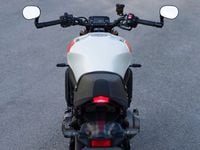Believe it or not, when Yamaha launched its current-generation XSR900 it referred to the bike as its most performance-oriented three-cylinder naked bike. Yes, there are the MT-09 and MT-09 SP, but according to Yamaha, MTs are intended to be more of a hooligan bike tailored toward the urban environment. The XSR900 is the bike for everything else, including canyon carving, trackdays, and of course looking good.
Last updated for the 2022 model year, the current-generation XSR900 borrows design cues from Yamaha’s early-to-mid ‘80s GP machines, which had boxier bodies and more diagonal lines than the 1970s machinery that inspired previous XSRs. Squint your eyes and you’ll see parts of a 1984 TZ250 here, which is neat if you’re a student of motorcycling’s past. Or just love a classic, retro look.
Additional styling touches come in the form of D-ring fasteners on the side covers, a hidden taillight, and a purposeful gap between the seat and tank, the latter mirroring the space between fuel tank and cowling on early-’80s GP bikes. Other niceties include bar-end mirrors and foldaway passenger footpegs.
How something goes is just as important as how it looks. To that end, Yamaha continues its approach of borrowing hard parts from the MT-09 and sprinkling model-specific pieces throughout.
The 890cc three-cylinder engine (overhauled in 2021) is the first of those pieces to have been borrowed from the MT. Almost every part of the engine, from the pistons and connecting rods to the crankshaft, camshafts, and crankcase, was redesigned as part of the update. Yamaha claimed a 6 percent increase in torque and less weight compared to the outgoing engine/exhaust package.
When strapped to the Cycle World dyno, the 2022 XSR900 we last tested produced 106.0 hp at 9,970 rpm and 63.5 lb.-ft. of torque at 7,030 rpm. That’s a modest but appreciated bump compared to the previous-generation XSR900, which produced 104.0 hp and 58.9 lb.-ft. of torque on the same dyno. Perhaps more importantly, the current-generation model has 3 percent taller gear ratios for smoother power delivery and reduced throttle snatching—something that plagued earlier CP3-powered models.
As part of the same model-year update, Yamaha changed the airbox and throttle bodies, boosting fuel economy from 44 to 49 mpg. A small change, perhaps, but sometimes that’s the difference between enjoying your last stretch of curves and worrying where the next gas station is.
Speaking of curves, the XSR rolls on Yamaha’s proven, alloy Deltabox frame, which uses varying wall thickness to get the best mix of weight, flex, and rigidity. It also uses spin-forged wheels, which reduce rotating and unsprung mass for a boost in handling. The bike is lighter than its predecessor, with a measured curb weight of 425 pounds. This despite having a longer swingarm and model-specific subframe.
For 2022, the steering head was lowered 30mm to increase front end feel.
That change, plus a 39mm (1.5 inches) shorter fork and retuned suspension, transformed the XSR900′s handling, making it more stable and less prone to dive or wheelies. And while that means the current-generation XSR is less playful than previous models, it’s still plenty entertaining and massive amounts of fun on a flowing section of road.
Unfortunately, all is not perfect with the suspension and chassis. While the fork is adjustable for preload, compression, and rebound, the XSR lacks compression damping adjustment on the shock. Big bumps cause the rear travel to blow through the compression damping, and it’s not long before you begin to scrape the footpeg feelers. The bike doesn’t become unstable, but it forces you to dial back the aggression slightly.
Brakes consist of dual four-piston calipers and 298mm rotors in the front and a single 245mm disc and single-piston caliper in the rear. Cornering ABS is standard and has two modes: BC-1 is standard ABS, while BC-2 adds lean sensitivity.
The list of electronic rider aids goes on thanks to the use of a YZF-R1-derived IMU that opens the door to a surprisingly expansive package. This includes Yamaha’s Traction Control System (TCS), Slide Control System (SCS), Lift Control System (LIF), and the aforementioned Brake Control (BC). Systems can be adjusted for different levels of intervention or turned off completely depending on rider preference. There are also four ride modes to choose from, and throttle sharpness will vary in each mode.
Traction control engagement is smooth and keeps the bike moving forward or around the corner without any hard cuts. TCS-2 (there are three settings) is more aggressive, but still seamless. The XSR900 is synonymous with wheelies, but maturity here means using Yamaha’s lift control, which does its job to bring the tire back to the pavement in a light and controlled manner.
Retro design meets sporty intentions once again when it comes to ergonomics, which were made more aggressive for 2022 but without going too far. For increased flexibility, footpegs can be positioned 14mm up and 4mm back by moving the brackets to the upper mounting holes. One thing you can’t get away from is the seat, which is firm and narrow, offering limited comfort for long rides.
Cruise control, a bidirectional quickshifter, and LED lighting are standard, as is Yamaha’s 3.5-inch TFT dash—modern touches that remind you the XSR900 is more than just a retro styling exercise. Of course, the XSR’s whole goal is to be both of those things: sporty and stylish. And thanks to years of practice, Yamaha has done a fine job of finding that balance.
The 2024 XSR900 is available in Heritage White for $10,299. No optional upgrades or different color choices, but do you really need them when the base color looks as good as this?

















/cloudfront-us-east-1.images.arcpublishing.com/octane/3TIWWRV4JBBOLDVGRYECVVTA7Y.jpg)
/cloudfront-us-east-1.images.arcpublishing.com/octane/KIX5O23D5NAIBGFXBN3327DKZU.jpg)
/cloudfront-us-east-1.images.arcpublishing.com/octane/7GJYDUIPXRGMTMQKN6ONYOLBOU.jpg)
/cloudfront-us-east-1.images.arcpublishing.com/octane/MUQLOVLL2ZDGFH25ILABNBXKTI.jpg)
/cloudfront-us-east-1.images.arcpublishing.com/octane/TNOU5DNE2BC57MFPMGN2EIDXAM.jpg)
/cloudfront-us-east-1.images.arcpublishing.com/octane/GTCXACQGJ5HAPDTGWUQKDEH44E.jpg)
/cloudfront-us-east-1.images.arcpublishing.com/octane/S35YGSEMEZB4BLTDJTSZPF4GLA.jpg)
/cloudfront-us-east-1.images.arcpublishing.com/octane/5UOT6HPX2JFMRJAX6EH45AR4MQ.jpg)
/cloudfront-us-east-1.images.arcpublishing.com/octane/OKWOJWAKP5EP3OACCRRWPCIX2Q.jpg)
/cloudfront-us-east-1.images.arcpublishing.com/octane/2WF3SCE3NFBQXLDNJM7KMXA45E.jpg)
/cloudfront-us-east-1.images.arcpublishing.com/octane/G4MG6OUCJNBSHIS2MVVOTPX65E.jpg)
/cloudfront-us-east-1.images.arcpublishing.com/octane/IIGGWFOTOJGB7DB6DGBXCCMTDY.jpg)
/cloudfront-us-east-1.images.arcpublishing.com/octane/QSTCM6AVEZA5JJBUXNIQ3DSOF4.jpg)
/cloudfront-us-east-1.images.arcpublishing.com/octane/U4I7G625B5DMLF2DVIJDFZVV6M.jpg)
/cloudfront-us-east-1.images.arcpublishing.com/octane/B6XD6LS6IVCQPIU6HXDJSM3FHY.jpg)
/cloudfront-us-east-1.images.arcpublishing.com/octane/ICL63FEDDRDTTMINYICCEYGMDA.jpg)
/cloudfront-us-east-1.images.arcpublishing.com/octane/FCGZHQXRBZFLBAPC5SDIQLVF4I.jpg)
/cloudfront-us-east-1.images.arcpublishing.com/octane/WNOB6LDOIFFHJKPSVIWDYUGOPM.jpg)

/cloudfront-us-east-1.images.arcpublishing.com/octane/X33NU3E525ECRHXLNUJN2FTRKI.jpg)
/cloudfront-us-east-1.images.arcpublishing.com/octane/6KKT5NNL2JAVBOXMZYS5ZO76YA.jpg)
/cloudfront-us-east-1.images.arcpublishing.com/octane/J5RKG5O455GMPGQRF2OG6LRT7A.jpg)
/cloudfront-us-east-1.images.arcpublishing.com/octane/GX2CIZKQVRH2TATDM26KFG2DAE.jpg)
/cloudfront-us-east-1.images.arcpublishing.com/octane/ZWIDYSAKQZHD5BHREMQILXJCGM.jpg)